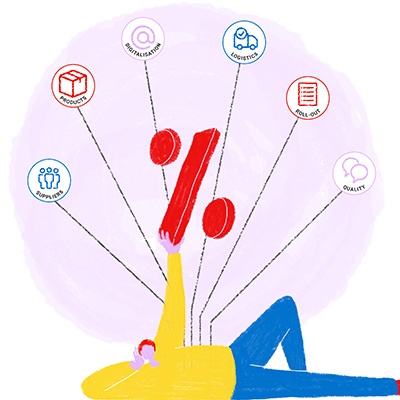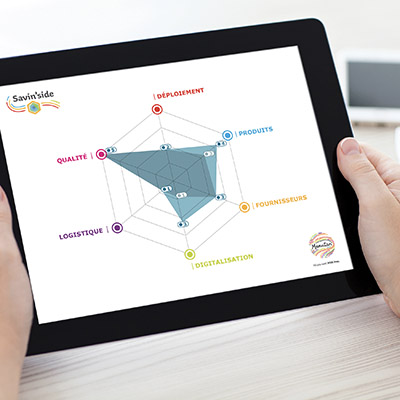Due to persistent economic uncertainties, supplier risk management has emerged as a strategic lever to secure procurement and guarantee supply chain continuity. Whether concerning quality, regulatory compliance, financial health, or reputation, identifying risks upstream enables businesses to build lasting relationships of trust with their suppliers. This article offers a comprehensive overview of definitions, risk categories, and concrete methods to better manage your supply chain and strengthen your organisation's protection.
Understanding supplier risks: From definition to strategic challenges
Before developing a risk management strategy, it is essential to identify and understand supplier risks to mitigate their impacts on the company.
Definition of supplier risk
Supplier risk management refers to all the processes implemented by a company to identify, assess, and anticipate potential failures of its suppliers, likely to affect the supply chain, procurement, quality, compliance, security, or reputation. These risks can be economic, logistical, financial, legal, environmental, or social in nature.
In a context of globalisation and tension on supply chains, risk management becomes a strategic lever to secure operations and protect the organisation's financial health. A poorly anticipated supplier risk can lead to delivery disruptions, contractual disputes, or damage to brand image. This is why many companies today integrate risk mapping into their procurement strategy.
Beyond economic challenges, supplier risk management is also part of a CSR approach and duty of care. It helps guarantee that suppliers respect social, environmental, and ethical standards, whilst building healthier and more responsible supplier relationships.
The challenges for the company
A failure in risk management can have serious consequences on several key aspects of the company:
- Financial health: supply disruption, cost increases, revenue losses.
- Reputation: bad press in case of ethical scandal or non-compliance.
- Quality: decreased performance of delivered products or services.
- Legal and ethical compliance: non-compliance with regulations, sanctions, loss of trust.
The company's protection therefore requires rigorous analysis, risk assessment tools, active monitoring, and genuine partnership with suppliers.
The different categories of supplier risks to identify and analyse
For effective supplier risk management, it is fundamental to know the types of risks your company may be exposed to, in order to better identify, assess, and anticipate them.
Risk typology
The diversity of suppliers implies a plurality of risks. Good management requires precise classification. Among the major categories to consider:
- Economic risks: these encompass dependence on a single supplier, financial failure, or price volatility. These risks can weaken the company's financial health and damage trust in the commercial relationship.
- Geopolitical and environmental risks: political instabilities, natural disasters, or new environmental regulations can disrupt global supply.
- Regulatory compliance risks: non-compliance with standards (customs, health, security, etc.) which can generate sanctions, delays, or disputes.
- Logistics and supply chain risks: delivery delays, supply chain disruptions, poor quality of goods... All threats to procurement security and quality.
- Social and ethical risks (CSR): hidden work, degrading working conditions, non-respect of human rights. These lapses cause strong reputational damage to the company.
Tools to identify risks
To anticipate, you must be able to identify risks systematically. This involves:
- A supplier risk mapping, a key tool to visualise critical points in the supply chain.
- A criticality analysis, combined with a scoring system, to prioritise areas to be treated as a priority.
- Regular supplier assessment, through audits, questionnaires, or performance indicators.
Concrete cases of poorly managed risks
Let's take the case of an industrial company that centralised 80% of its strategic supply on a single supplier located in a region exposed to growing geopolitical tensions. Despite warning signals (political instability, local currency fluctuations and regulatory changes), no diversification measures were implemented. When a local crisis erupted — border closures, massive strikes, transport disruptions — the supplier was no longer able to deliver.
This situation led to a brutal supply chain disruption, causing the shutdown of certain production lines for several weeks. Lacking buffer stock or alternative suppliers, the company had to postpone its deliveries, losing key customers to better-prepared competitors. The consequences were multiple: significant financial losses, decreased trust from commercial partners, and deteriorated reputation with investors.
This example illustrates the vital importance of supplier dependency analysis, updated risk mapping, and implementation of operational continuity plans. It also reminds us that supply chain resilience requires a proactive strategy, active monitoring, and close collaboration with a network of diversified suppliers.
Methods and best practices to secure your procurement
Supplier risk management is not limited to prevention: it also relies on concrete methods and sustainable collaboration dynamics with suppliers.
Strategies for proactive management
Effective risk management begins with a structured and anticipative process. It is essential to implement continuous supplier assessment to monitor their financial health, production capacity, regulatory compliance, and alignment with the company's CSR objectives.
Having contingency plans — such as "plan B" suppliers, alternative supply sources, or buffer stocks — enables supply chain security in case of a crisis.
Beyond tools, building trust and long-term relationships is a guarantee of stability. A company that values transparency, quality, and listening in its supplier relationship consolidates its protection against supplier risks.
Integrating suppliers into your procurement strategy
Including your suppliers in your strategic thinking allows you to go beyond simple risk management. Co-development of solutions and real-time information sharing strengthen mutual trust and encourage innovation.
It's no longer just about evaluating them but supporting them to help them grow with you. This responsible approach promotes supply chain resilience whilst strengthening your position as preferred buyer.
Management tools
To effectively manage supplier risk management, several tools are available:
- Risk management software systems and risk mapping allowing visualisation of critical areas.
- Integration of CSR criteria and duty of care in specifications and contracts.
- Dashboards and KPIs to continuously monitor performance and supplier risk level.
This regular analysis enables identification of emerging risks and sustainably secures your procurement.
Mastering supplier risks is no longer an option, but a strategic necessity for any company wishing to secure its procurement, strengthen its resilience, and build lasting relationships. By combining anticipation, appropriate tools, and responsible collaboration, you lay the foundations for a robust, agile supply chain in phase with today's economic, social, and environmental challenges.
[1] Fanny, BENARD (Associate Director, BuyYourWay), Le débat, SMART @WORK, 17 December 2022, 22 min, B-Smart, [https://www.bsmart.fr/video/17575-smart-work-partie-17-decembre-2022]
[2] Antoine, COMPIN (Managing Director, Manutan France), Le débat, SMART @WORK, 17 December 2022, 22 min, B-Smart, [https://www.bsmart.fr/video/17575-smart-work-partie-17-decembre-2022]
[3] Bertrand, POUILLOUX (Procurement Manager, Enedis), Le débat, SMART @WORK, 17 December 2022, 22 min, B-Smart, [https://www.bsmart.fr/video/17575-smart-work-partie-17-decembre-2022]








